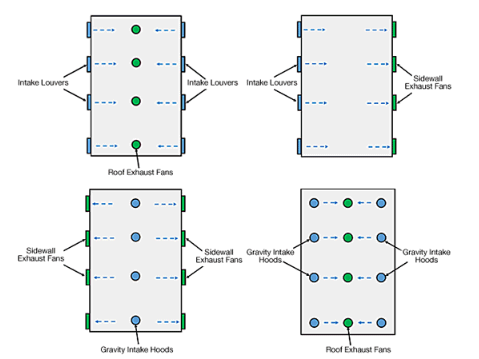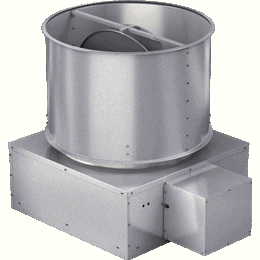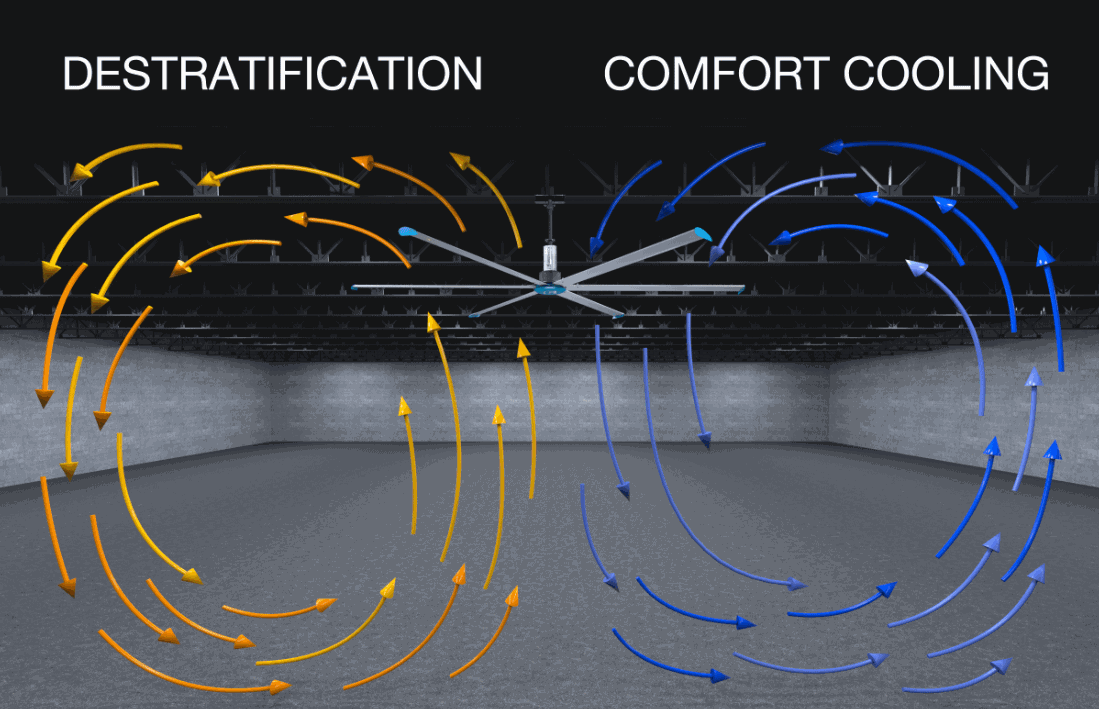Over the years, the “warehouse” has evolved from a simple structure, having minimal occupants and inefficient processes to one that focuses on health & safety, streamlined with automation and dedicated areas for operational activities such as packaging, sorting, and loading. Due to an increase in online ordering and consumer transactions in general, the warehouse we see today needs to handle more products and become increasingly more efficient.
When designing a warehouse, it is critical to think about how you will heat & cool the space, provide fresh outdoor air, and provide air movement throughout the building. The once simple box design is now more cumbersome. You must take into consideration how often large bay doors open & close, how many indoor powered vehicles are operating, how tall the ceilings are, and the placement of HVAC equipment to ensure proper ventilation and conditioning.
Summer Ventilation
Depending on your location, summertime can be very hot and humid, so it is critical to keep the space cooler and comfortable for the occupants. You want to remove that hot and humid air from the space and replace it with outdoor air approximately 1 to 3 times every hour.
Removing air from the space can be accomplished several ways:
- Roof exhaust and intake louvers
- Sidewall cross ventilation
- Sidewall exhaust and roof intake
- Roof exhaust and roof intake
The most common design that you will see, is having a system with roof exhaust and intake louvers because it is not only the most efficient but also the most cost-effective.
Exhaust Air
Roof exhaust fans such as Greenheck models RBU, RBUMO, and TAUB, are used as roof mounted models to exhaust air from the space. Model RBUMO is a belt-driven fan and is one of the most popular models used in warehouse applications. This fan has an airflow capacity of up to 68,000 cfm and 1.0 in. wg. Since it has the motor located out of the airstream, it can carry a UL-793 high temperature rating as well as UL emergency smoke control.
If you don’t have space on the roof, another option to exhaust air from the space would be to use a sidewall propeller fan. Sidewall prop fans are easy to install and can move a large amount of air at a lower pressure. This fan type is available in a belt-drive or direct-drive configuration and either steel or aluminum blades.
Greenheck model AER is an aluminum blade direct-drive fan with an airflow capacity of up to 78,600 cfm. Since it is a direct drive fan, there is an option for a Vari-Green EC (electronically commutated motor) which opens the door for controls. Since a sidewall propeller fan can be exposed to the occupants, it is imperative to include a protective guard. A motor side guard made of welded steel wire will enclose the motor and drive side of the fan while an OSHA (Occupational Safety and Health Administration) motor side guard will completely enclose the motor/drive. These construction features will ensure the safety of the occupants while still allowing for proper maintenance of the fan.
Intake Air
Aside from exhausting air from the building, you also need a way to let air in. Louvers are commonly used to allow airflow into a warehouse, while protecting the space from water entrainment, dirt, wind, and noise. Louvers are either stationary or operable and can work in conjunction with a damper. Depending on your location, you may need to consider a higher performing louver, that is designed specifically for wind-driven rain or one that can withstand a hurricane.
The three louver styles typically used in a warehouse are:
- Adjustable Blade Louver
- This is the most common louver used as it provides the lowest cost for intake of that air. Greenheck model EAD-635 is an adjustable extruded aluminum louver with drainable blades.
- Combination Louver/Damper
- Greenheck model ECD offers a fixed blade appearance and an improved leakage rate.
- Stationary Louver/Damper
- Greenheck model ESD provides the best leakage rating and insulated dampers can be used for increased thermal performance.
Although the louver can be used alone, adding a damper can help control the airflow into the building, keep water out, and help regulate temperature. Volumetric control dampers with either steel or aluminum blades are most used. Greenheck model VCD has a leakage rate of Class 1A 3.0 cfm/ft2 @ 1 in. wg and an operating temperature of -40°F to 250 F. Adding an insulated control damper to your application can help increase the thermal performance of the building since the blades are thermally broken. This helps minimize the transfer of thermal energy (outside/inside) and reduces the potential for condensation. Greenheck model ICD has a leakage rate of Class 1A 3.0 cfm/ft2 @ 1 in. wg and an operating temperature of -70°F to 200°F. For damper control, you can include either a motorized actuator, a manual actuator, or a pull chain.
Air Circulation
Air circulation in summer is necessary to provide a cooling effect for the occupants while also maintaining a safe and comfortable environment. In the summer, there is the potential for “slab sweat”, which are wet areas on the floor. We all know that a wet floor is an accident waiting to happen, so to prevent this from happening, we want to properly circulate the air to keep those floors dry. Greenheck’s model DS has an airflow capacity of up to 243,000 cfm and can cover up to 23,700 square feet of space with one fan.
Fan placement is also critical when trying to achieve optimal air circulation. You want to make sure that the fans are installed in areas of the warehouse that have the highest foot traffic. You also want to make sure that they aren’t obstructed by any structures – such as machinery, shelving, or ductwork.
Improved air circulation through destratification fans can reduce cooling energy costs by up to 30% and help reduce that first cost for the HVAC system. Fans are easily controlled through a keypad, touchscreen control, or BMS (building management system).
Winter Ventilation
Winter can also be a challenging time of year depending on your location. Each time a large bay door is opened, you lose a significant amount of warm air from the space. This can cause discomfort for the occupants as increase the heating costs for the buildings. Tall ceilings also cause issues for the space due to rising heat, removing that warmth from the occupant level.
There are two ways to provide space heat to a warehouse:
100% outdoor air units, such as Greenheck model DGX, provide 100% outdoor air to the space at high temperatures (120-140°F). This direct-fired unit will discharge that high-velocity, high temperature air to the space at a downward angle and is controlled locally (thermostat) based on the requirements of that zone.
80/20 recirculating units provide anywhere from 20 to 100% outdoor air through modulating outdoor air and return air dampers. Discharge temperatures range anywhere from 80 to 110°F based on a remote temperature sensor and the supply fan will run continuously to respond to varying exhaust airflows.
Air circulation in winter is necessary to mix that warm and cool air evenly throughout the space. Destratification fans help to push that warmer air back down into the occupied space. Air circulation through destratification fans can help reduce heating energy costs by up to 25%.
Summer Ventilation
As we mentioned, warehouses are evolving and so are the ideal indoor conditions of those spaces. Everything is based around occupancy comfort so when people FEEL more comfortable as it applies to indoor working conditions (temperature/humidity), they are more likely to be more productive and more effective. As we have discussed, a cooling effect through destratification fans can be effective, however, depending on your location, mechanical cooling may need to be added.
There are two different methods for cooling the space:
- Sensible cooling with a discharge temperature of ~70°F
- Latent cooling (dehumidification) with a discharge temperature of ~55°F
Sensible cooling, which is the removal of heat (not moisture), is a more cost-effective way to apply that cooling effect to the space, providing just enough “cold” air for people to feel more comfortable. This method would be ideal for hot & dry climates. A make-up air unit, like model DGX, can utilize packaged DX (direct expansion), split DX cooling, or chilled water and provide a discharge air temperature of roughly 70°F. This temperature will certainly feel cooler than say 80°F+ air coming in during the summer.
Latent cooling (dehumidification) is more expensive, but it will provide dehumidified air to the space which is ideal for hot & humid climates. To dehumidify the air, a rooftop unit must cool it to roughly 50 to 55°F, ensuring that the moisture is removed. Greenheck’s model RV can provide 100% outside air with either a packaged DX, split DX, chilled water, or air-source heat pump configuration and really strip the moisture out of the air being provided to the space. Whether it be summer or winter seasons, you must be aware as to how often and how long bay doors are kept open, because you don’t want to lose that conditioned air to the outside environment!
When working on your next warehouse project, keep Brucker and Greenheck in mind for your project requirements. Work with industry experts to help provide you the best warehouse package – not only for product performance but efficiency and cost!
- Warehouses. Greenheck. (n.d.). Retrieved January 16, 2023, from https://www.greenheck.com/resources/building-types/warehouses
- Fans. Greenheck. (n.d.). Retrieved January 16, 2023, from https://www.greenheck.com/products/air-movement/fans/roof-mounted-fans/axial-upblast-exhaust-fans
- Product Application Guide. HVLS High Volume Low Speed Fans. (n.d.). Retrieved January 16, 2023, from https://content.greenheck.com/public/DAMProd/Original/10012/fa-129-19-hvls-high-volume-low-speed-fans.pdf
- Industrial Space Heating. (n.d.). Retrieved January 16, 2023, from https://content.greenheck.com/public/DAMProd/Original/10002/industrialspaceheating.pdf





Recent Comments